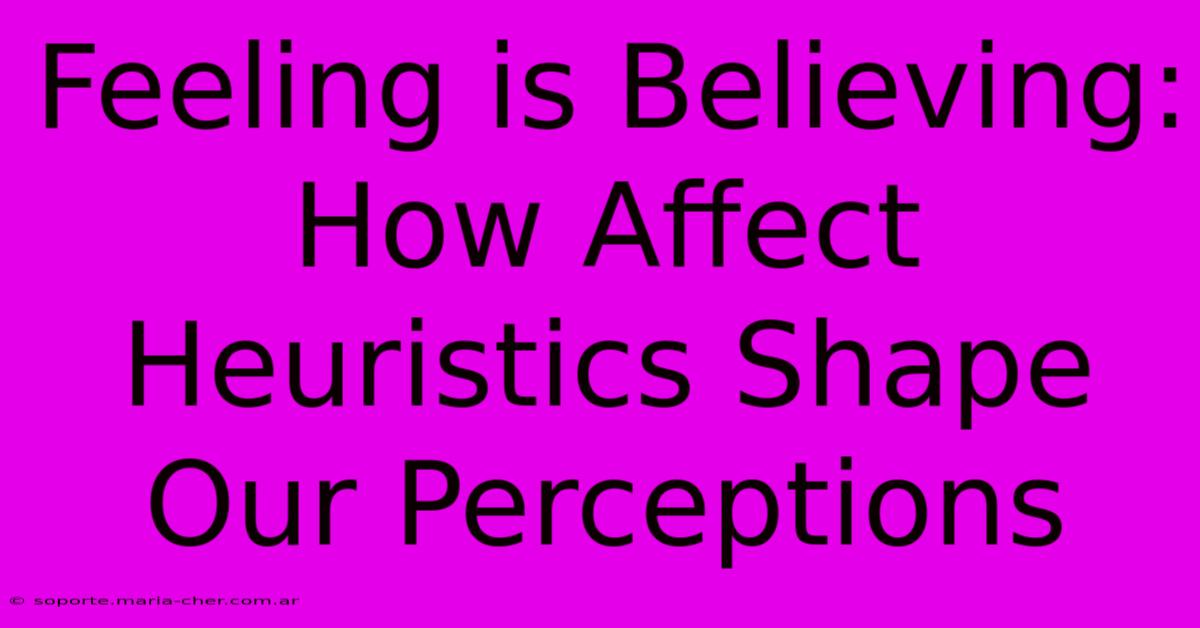Feeling Is Believing: How Affect Heuristics Shape Our Perceptions

Table of Contents
Feeling is Believing: How Affect Heuristics Shape Our Perceptions
We often pride ourselves on our rationality, our ability to make decisions based on logic and reason. Yet, a significant portion of our choices are driven by something far less tangible: our feelings. This is where affect heuristics come into play – the powerful, often unconscious, influence of emotions on our judgments and decisions. This article delves into the fascinating world of affect heuristics, exploring how these emotional shortcuts shape our perceptions and understanding of the world around us.
Understanding Affect Heuristics: The Emotional Shortcut
Affect heuristics are mental shortcuts that rely on our immediate, gut feelings (affect) to make judgments and decisions. Instead of meticulously weighing pros and cons, we often rely on a quick, emotional assessment: "Does this feel good? Or does it feel bad?" This "feeling" then informs our perception of the situation, object, or idea. This seemingly simple process significantly impacts how we perceive risk, value, and likelihood.
How it Works: The Simple Equation
The core mechanism of affect heuristics is surprisingly straightforward. We associate an object, event, or idea with a particular feeling – positive or negative. This emotional tag then colors our perception of its other attributes. For instance:
- Positive Affect: If we feel good about a particular brand, we might automatically perceive its products as higher quality, more reliable, and more valuable, even without concrete evidence.
- Negative Affect: Conversely, a negative feeling (fear, anxiety, disgust) associated with something like nuclear power might lead us to overestimate its risks and downplay its potential benefits.
The Impact of Affect Heuristics on Our Daily Lives
Affect heuristics are pervasive, influencing decisions across a vast spectrum of our lives:
- Product choices: Marketing campaigns skillfully leverage affect heuristics, associating their products with positive emotions (happiness, excitement, security) to sway consumer choices. Think of cheerful jingles or heartwarming commercials.
- Political opinions: Our political leanings are often deeply intertwined with emotional responses. We might support a candidate because they evoke feelings of trust and hope, while rejecting another due to feelings of distrust or anger.
- Risk perception: Our emotional responses significantly shape how we perceive risks. We might overestimate the risks associated with activities that trigger fear (e.g., flying) while underestimating the risks of more familiar, less emotionally charged activities (e.g., driving).
- Health decisions: Emotional responses play a crucial role in healthcare choices. Fear of a specific treatment might lead individuals to avoid seeking necessary medical attention, even if the potential benefits outweigh the risks.
The Cognitive Bias Effect
It's crucial to acknowledge that affect heuristics are not always rational or accurate. They can lead to cognitive biases, systematic errors in thinking that distort our judgments. For example:
- Availability heuristic: We overestimate the likelihood of events that evoke strong emotions, even if they are statistically less probable.
- Confirmation bias: We tend to seek out and favor information that confirms our pre-existing emotional responses.
Harnessing the Power of Affect Heuristics
While affect heuristics can lead to biases, understanding their mechanisms can empower us to make more informed decisions. By becoming more aware of our emotional responses, we can:
- Identify potential biases: Recognizing the influence of emotions on our judgments allows us to question our assumptions and seek more objective information.
- Improve decision-making: By consciously separating emotions from facts, we can make more rational choices, reducing the likelihood of being swayed by fleeting feelings.
- Enhance communication: Understanding how affect heuristics influence others' perceptions can help us communicate more effectively, tailoring our messages to resonate with their emotional responses.
Conclusion: A Balancing Act
Affect heuristics are an inherent part of human cognition, acting as powerful, often invisible, drivers of our perceptions and choices. While they can lead to biases, acknowledging their influence allows us to navigate the complexities of decision-making with a greater degree of self-awareness and rationality. The key is to find a balance – to harness the power of emotions while also striving for objective assessment, ultimately leading to more informed and effective decisions.

Thank you for visiting our website wich cover about Feeling Is Believing: How Affect Heuristics Shape Our Perceptions. We hope the information provided has been useful to you. Feel free to contact us if you have any questions or need further assistance. See you next time and dont miss to bookmark.
Featured Posts
-
Gold Vermeil Bracelets The Perfect Gift For Her And Him
Feb 07, 2025
-
Unleash Creativity With A Customizable Saddle Stitched Wall Calendar
Feb 07, 2025
-
Black And White Revelation Aperture Control For Soulful Images
Feb 07, 2025
-
From Everyday Chic To Red Carpet Radiance The Versatile Charm Of Gold Vermeil Necklaces
Feb 07, 2025
-
Exposed The 9 Most Common Fallacies Used In Advertising You Wont Believe 3
Feb 07, 2025
